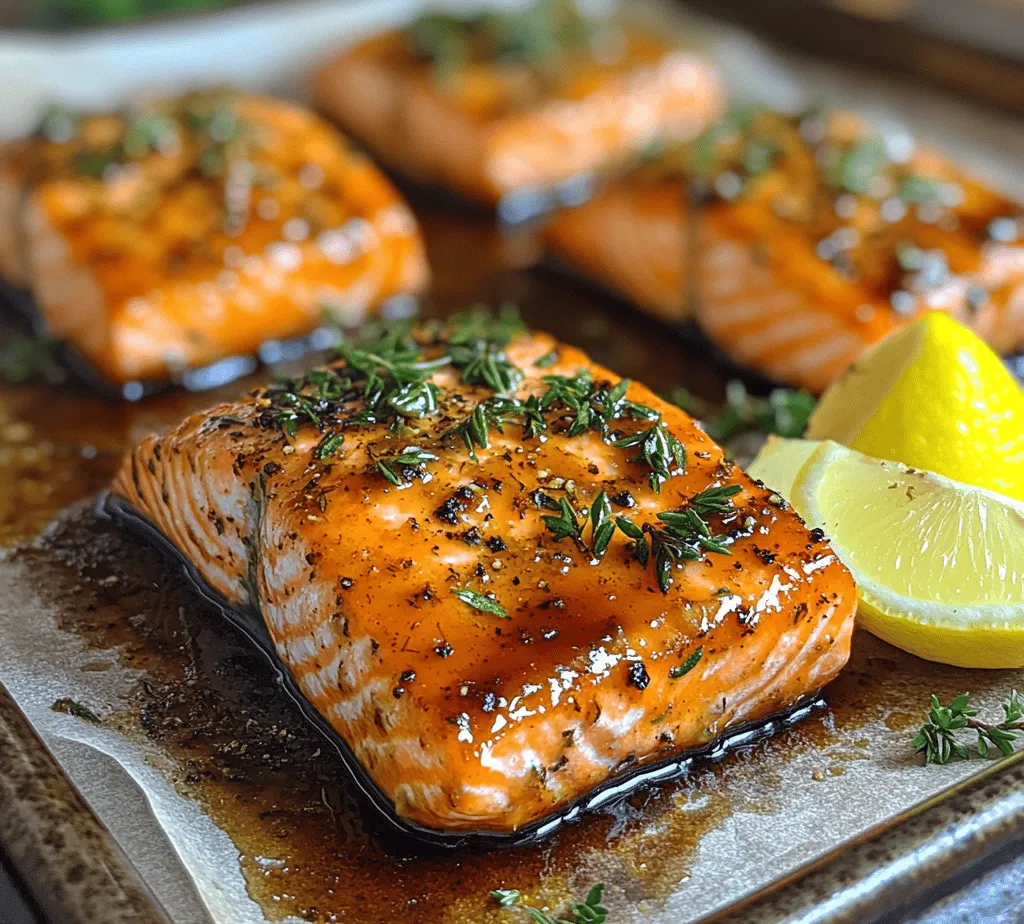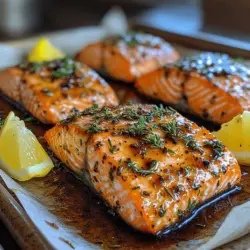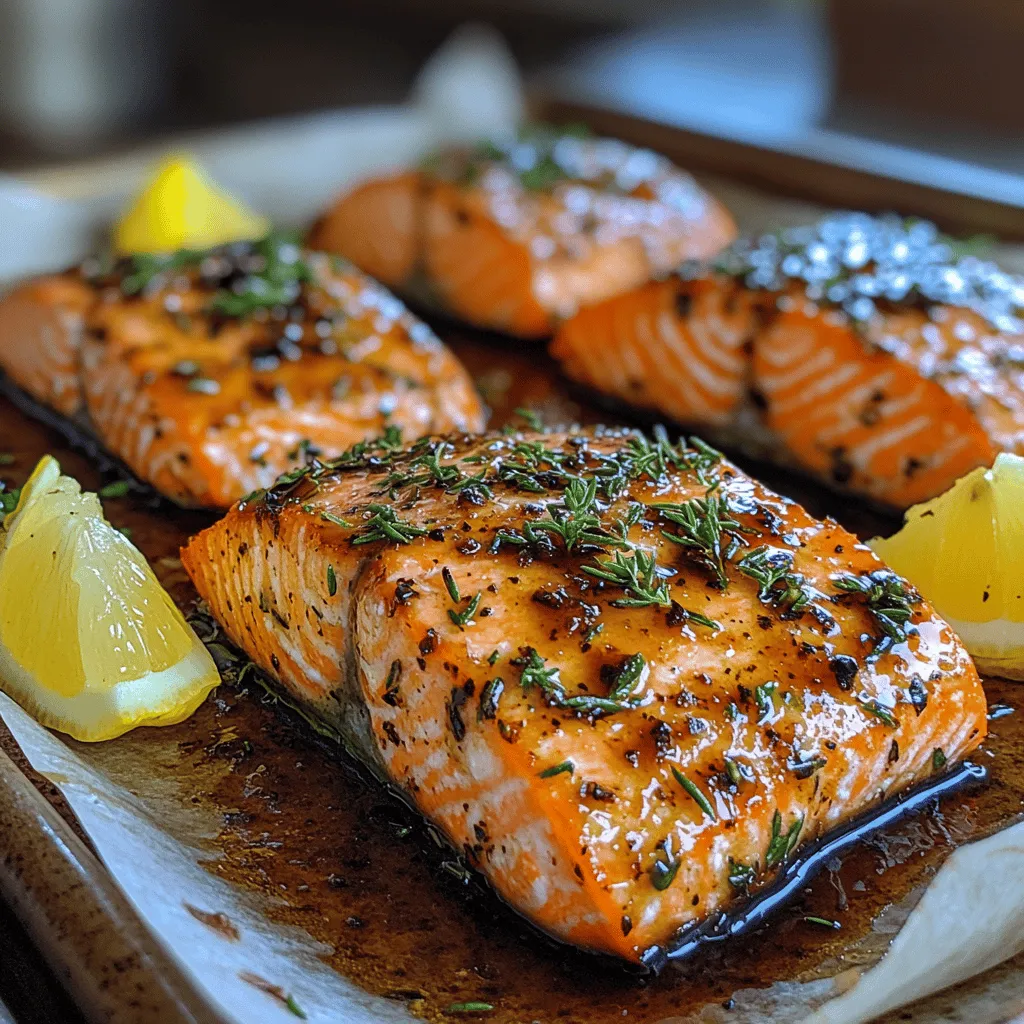Introduction
Understanding the art of cooking fish can elevate your culinary skills, and one of the most delectable ways to prepare salmon is by glazing it with a rich balsamic sauce. This Balsamic Glazed Salmon with Honey & Herbs recipe not only brings out the natural flavors of the fish but also introduces a delightful balance of sweetness and acidity. In this article, we will explore the ingredients, preparation steps, and the benefits of this dish, ensuring you have all the information you need to create a restaurant-quality meal in your own kitchen.
Salmon has long been a favorite among chefs and home cooks alike, thanks to its versatility, rich flavor, and impressive nutritional profile. The combination of balsamic vinegar and honey in this recipe creates a luscious glaze that caramelizes beautifully when cooked, enhancing the dish’s appeal. Whether you’re preparing a weeknight dinner for your family or hosting a dinner party for friends, this recipe is sure to impress.
The Allure of Balsamic Glazed Salmon
Salmon has been a staple in culinary traditions worldwide, from the Pacific Northwest to Nordic countries. Its popularity stems from its rich, buttery flavor and firm texture, making it a prime candidate for various cooking methods such as grilling, baking, and broiling. The fish is not only delicious but also incredibly nutritious, packed with protein and omega-3 fatty acids that promote heart health and brain function.
The unique flavor profile of balsamic vinegar and honey is what truly sets this dish apart. Balsamic vinegar, with its deep, complex taste, is crafted from freshly crushed grape must and aged in wooden barrels, resulting in a tangy yet slightly sweet condiment. When paired with the natural sweetness of honey, the balsamic glaze transforms into a harmonious sauce that complements the richness of the salmon beautifully.
In addition to its fantastic flavor, this dish boasts numerous health benefits. Salmon is an excellent source of lean protein and is rich in essential nutrients, including vitamins B12 and D, selenium, and potassium. The herbs used in the marinade, such as rosemary and thyme, are not only aromatic but also packed with antioxidants and anti-inflammatory properties. Together, these ingredients create a meal that is not only satisfying to the palate but also nourishing for the body.
Ingredients Breakdown
To create this Balsamic Glazed Salmon with Honey & Herbs, you’ll need a handful of simple yet flavorful ingredients. Let’s take a closer look at each one and understand their role in the dish:
Salmon Fillets
Salmon fillets are the star of this recipe. Not only do they provide a rich, buttery flavor, but they are also an excellent source of omega-3 fatty acids, which are essential for heart health and brain function. When selecting salmon, look for fillets that are firm, moist, and have a vibrant color. Wild-caught salmon is generally considered to be the healthier option, but farmed salmon can also be a sustainable choice.
Balsamic Vinegar
Balsamic vinegar is a key ingredient that adds depth and complexity to the glaze. Originating from Modena, Italy, traditional balsamic vinegar is made from grape must and aged for several years, resulting in a thick, syrupy consistency and a rich flavor. For this recipe, you can use either traditional balsamic vinegar or a more commercially available variety, depending on your preference and budget.
Honey
Honey serves as a natural sweetener in this dish, balancing the acidity of the balsamic vinegar and enhancing the overall flavor. It adds a subtle sweetness that caramelizes beautifully when cooked, creating a beautiful glaze. Additionally, honey has numerous health benefits, including antimicrobial properties and antioxidants.
Dijon Mustard
Dijon mustard adds a layer of depth and complexity to the marinade, contributing a tangy flavor that complements the sweetness of the honey and the acidity of the balsamic vinegar. It also helps to emulsify the marinade, ensuring that the flavors are well combined and cling to the salmon.
Olive Oil
Olive oil is an essential ingredient in this recipe, providing healthy fats that enhance the flavor and texture of the dish. It also helps to keep the salmon moist during cooking. When selecting olive oil, choose extra virgin for the best flavor and health benefits.
Herbs (Rosemary and Thyme)
Fresh herbs like rosemary and thyme bring aromatic flavors to the marinade, complementing the salmon’s richness. Both herbs have their own unique health benefits; rosemary is known for its antioxidant properties, while thyme has antimicrobial effects and can aid in digestion.
Garlic
Garlic is a flavor powerhouse that enhances the dish’s overall aroma and taste. It adds a savory depth that contrasts beautifully with the sweetness of the honey and the tanginess of the balsamic vinegar. Additionally, garlic is known for its numerous health benefits, including boosting the immune system and reducing blood pressure.
Seasoning (Salt and Pepper)
Finally, don’t underestimate the role of seasoning in enhancing the overall taste of the dish. A pinch of salt and freshly cracked black pepper can elevate the flavors of the salmon and the marinade, ensuring a well-rounded and delicious meal.
Preparing the Marinade
Now that we’ve broken down the ingredients, it’s time to prepare the marinade for your Balsamic Glazed Salmon. The marinade is the key to infusing the fish with flavor, so it’s essential to balance the ingredients for the best result.
Step-by-Step Instructions for Creating the Marinade
1. Gather Ingredients: Start by gathering all the marinade ingredients: balsamic vinegar, honey, Dijon mustard, olive oil, minced garlic, fresh rosemary, fresh thyme, salt, and pepper.
2. Mix the Base: In a medium-sized mixing bowl, combine 1/4 cup of balsamic vinegar, 2 tablespoons of honey, and 1 tablespoon of Dijon mustard. Using a whisk, mix these ingredients together until they are well combined and smooth.
3. Incorporate the Oil: Gradually drizzle in 1/4 cup of extra virgin olive oil while whisking continuously. This technique helps to emulsify the marinade, creating a thicker consistency that will adhere to the salmon fillets.
4. Add Aromatics: Next, add 2 cloves of minced garlic, 1 tablespoon of finely chopped fresh rosemary, and 1 tablespoon of finely chopped fresh thyme to the bowl. Stir well to ensure the herbs and garlic are evenly distributed throughout the marinade.
5. Season: Finally, season the marinade with a pinch of salt and freshly cracked black pepper to taste. This step is crucial, as it enhances the flavors of the marinade and the salmon itself.
Importance of Balancing Flavors in the Marinade
Achieving the perfect balance of flavors in your marinade is essential for a successful dish. The acidity from the balsamic vinegar, sweetness from the honey, and depth from the mustard should all harmonize to complement the salmon’s natural flavor. If you prefer a sweeter glaze, feel free to adjust the amount of honey to your liking. Conversely, if you enjoy a more tangy profile, adding a little more balsamic vinegar can enhance that flavor.
Tips for Achieving the Perfect Consistency and Taste
– Taste Test: Always taste the marinade before using it. This allows you to adjust the flavors according to your preferences. If it leans too sweet, add a splash more vinegar; if it’s too tangy, incorporate a bit more honey.
– Fresh Ingredients: Use fresh herbs and quality ingredients for the best flavor. Fresh herbs can elevate the dish significantly compared to dried herbs.
– Marinating Time: Allowing the salmon to marinate for at least 30 minutes (or up to 2 hours) is crucial for flavor absorption. The longer the fish sits in the marinade, the more pronounced the flavors will become.
The Role of Marinating Time in Flavor Absorption
Marinating not only imparts flavor to the salmon but also helps to tenderize the fish, enhancing its texture. As the salmon sits in the marinade, it absorbs the flavors, resulting in a dish that is rich and aromatic. However, it’s important not to marinate for too long, especially if the marinade contains acidic ingredients like balsamic vinegar, as this can lead to a mushy texture. Aim for a balance where the fish is flavorful yet retains its firm texture.
Marinating the Salmon
Once your marinade is ready, it’s time to marinate the salmon fillets. This step is straightforward but vital for ensuring that your dish is bursting with flavor.
1. Prepare the Salmon: Place the salmon fillets in a shallow dish or a resealable plastic bag. Make sure the skin side is down, as this will help the flesh absorb the marinade better.
2. Add the Marinade: Pour the prepared marinade over the salmon, ensuring each fillet is evenly coated. If using a plastic bag, seal it tightly and gently massage the marinade into the fish.
3. Refrigerate: Cover the dish or seal the bag and refrigerate for at least 30 minutes. For optimal flavor, aim to marinate for 1-2 hours. This allows the salmon to soak up all the delicious flavors of the balsamic glaze.
4. Ready to Cook: After marinating, remove the salmon from the refrigerator and let it sit at room temperature for about 15 minutes before cooking. This helps the fish cook more evenly.
By following these steps, you’re well on your way to creating a mouthwatering Balsamic Glazed Salmon with Honey & Herbs. In the next section, we will cover the cooking methods and techniques to achieve the perfect finish for this delightful dish. Stay tuned for more delicious details!

Best Practices for Marinating Fish
Marinating fish like salmon is an essential step in enhancing its flavor and texture. When done correctly, marinating not only infuses the fish with rich flavors but also helps to tenderize it. Here are some best practices to follow for marinating your salmon effectively.
Types of Containers:
Choosing the right container for marinating is crucial. You have two primary options: a shallow dish or a resealable plastic bag. A shallow dish allows for even exposure to the marinade, while a resealable plastic bag offers the advantage of minimizing space and ensuring that the marinade coats the fish thoroughly. If you use a bag, remember to press out excess air to allow the marinade to envelop the fish completely.
Recommended Marinating Times for Optimal Flavor:
For salmon, marinating for 30 minutes to 2 hours strikes the perfect balance. Shorter marinating times (around 30 minutes) will impart a light flavor, while longer times (up to 2 hours) will deepen the flavors without compromising the fish’s texture. Avoid marinating for more than 2 hours, as the acidity in the marinade can begin to break down the fish too much, leading to a mushy texture.
How Marinating Affects Texture and Taste:
Marinating not only enhances the flavor profile of your salmon but also affects its texture. The acids in the marinade (like balsamic vinegar and honey) help to tenderize the fish by breaking down protein structures. This results in a more succulent and flavorful piece of salmon. Additionally, herbs in the marinade contribute aromatic compounds that elevate the dish’s overall taste, making each bite more enjoyable.
Cooking Methods for Salmon
When it comes to cooking salmon, the method you choose can significantly affect the final result. Two popular techniques for preparing salmon are baking and broiling, each with its own set of advantages.
Comparison of Baking and Broiling Techniques:
Baking is a gentle cooking method that allows for even cooking throughout the salmon fillet. It’s particularly beneficial for thicker pieces of salmon. Broiling, on the other hand, is a high-heat cooking method that cooks the fish quickly and can create a delicious caramelization on the glaze, enhancing the flavor.
Detailed Steps for Baking Salmon Perfectly:
1. Preheat the Oven: Start by preheating your oven to 375°F (190°C). This temperature is ideal for gently cooking the salmon while preserving its moisture.
2. Prepare the Baking Sheet: Line a baking sheet with parchment paper. This not only prevents the salmon from sticking but also makes for easy cleanup.
3. Arrange the Salmon: Place the marinated salmon fillets skin-side down on the prepared baking sheet. Make sure to pour any remaining marinade over the top for added flavor.
4. Bake: Cook the salmon in the preheated oven for about 15-20 minutes, depending on the thickness of the fillets. The salmon should be opaque and flake easily with a fork when it’s done.
5. Check for Doneness: A meat thermometer can be very helpful; the internal temperature should reach 145°F (63°C) for safe consumption.
Importance of Using Parchment Paper for Easier Cleanup:
Using parchment paper is a game-changer when it comes to cooking salmon. It minimizes the mess and prevents the fish from sticking to the pan, making it easier to serve. Plus, it helps retain moisture, ensuring that your salmon remains tender and juicy.
How Broiling Can Enhance the Final Glaze:
If you prefer a crispy top, consider finishing the salmon under the broiler. After baking, switch your oven to broil and cook the salmon for an additional 2-3 minutes. Keep a close eye on it to prevent burning. Broiling will caramelize the balsamic glaze, creating a beautiful, sticky finish that enhances the dish’s overall appeal.
Serving Suggestions
Presentation plays a key role in the enjoyment of any dish, and salmon is no exception. Here are some creative ideas for plating your Balsamic Glazed Salmon with Honey & Herbs, along with ideal side dishes.
Creative Ideas for Plating the Salmon:
To create an inviting presentation, place the salmon fillet slightly off-center on a plate. Drizzle some of the remaining glaze over the top, allowing it to pool on one side for an artistic effect. Garnish with freshly chopped herbs or microgreens for a pop of color.
Pairing with Sides:
When it comes to sides, consider light and fresh accompaniments that won’t overpower the salmon. Here are some recommendations:
– Vegetable Sides: Roasted asparagus, sautéed green beans, or a mixed green salad with a light vinaigrette pair beautifully with the rich flavors of the salmon.
– Grains: Quinoa, couscous, or wild rice are excellent choices. These grains can absorb the delicious glaze and add a hearty element to the dish.
Importance of Garnishing for Presentation:
A well-garnished plate can elevate the dining experience. Consider adding a few lemon wedges on the side, which not only enhance the flavor profile but also add visual appeal. A sprinkle of sesame seeds or a few sprigs of fresh herbs can create a sophisticated look.
Using Lemon Wedges:
Lemon wedges serve a dual purpose. They not only provide a bright, zesty flavor that complements the richness of the salmon but also add a vibrant touch to the plate. Encourage your guests to squeeze the lemon over their salmon just before eating for an added layer of freshness.
Nutritional Benefits of Balsamic Glazed Salmon
This delicious salmon dish not only pleases the palate but also boasts impressive nutritional benefits that make it a smart choice for a balanced diet.
Analysis of the Nutritional Profile of the Dish:
A single serving of Balsamic Glazed Salmon contains approximately 350 calories, depending on the size of the fillet and the amount of glaze used. It’s a great source of high-quality protein, essential for muscle repair and overall health.
Caloric Breakdown per Serving:
– Calories: 350
– Protein: 34g
– Fat: 20g (mostly healthy fats from the salmon)
– Carbohydrates: 12g (primarily from honey and balsamic vinegar)
Benefits of the Ingredients Combined:
Salmon is rich in omega-3 fatty acids, which are known for their heart health benefits. Balsamic vinegar adds antioxidants, helping to combat inflammation, while honey provides natural sweetness and is packed with vitamins and minerals. The herbs contribute additional antioxidants and flavor without extra calories.
How This Dish Fits into a Balanced Diet:
Incorporating Balsamic Glazed Salmon into your weekly meal plan can contribute to a well-rounded diet. It provides a healthy balance of protein, healthy fats, and carbohydrates, particularly when paired with whole grains and an array of colorful vegetables. This dish is not only satisfying but also supports overall health and wellness.
Conclusion
Balsamic Glazed Salmon with Honey & Herbs is more than just a meal; it’s a celebration of flavor, health, and simplicity. The ease of preparation—combined with the rich, balanced flavors of balsamic vinegar, honey, and fresh herbs—makes it an accessible dish for both novice cooks and seasoned chefs alike.
The versatility of this recipe allows you to experiment with different sides and garnishes, ensuring that each meal can be a new culinary adventure. Whether you’re hosting a dinner party or enjoying a quiet night in, this salmon dish is sure to impress.
Encouraging readers to dive into cooking salmon at home not only opens the door to a world of flavors but also promotes healthier eating habits. So gather your ingredients, follow the steps, and enjoy the delightful experience of crafting this delicious Balsamic Glazed Salmon. Each bite will remind you that cooking can be both a pleasure and a path to nourishing your body.

